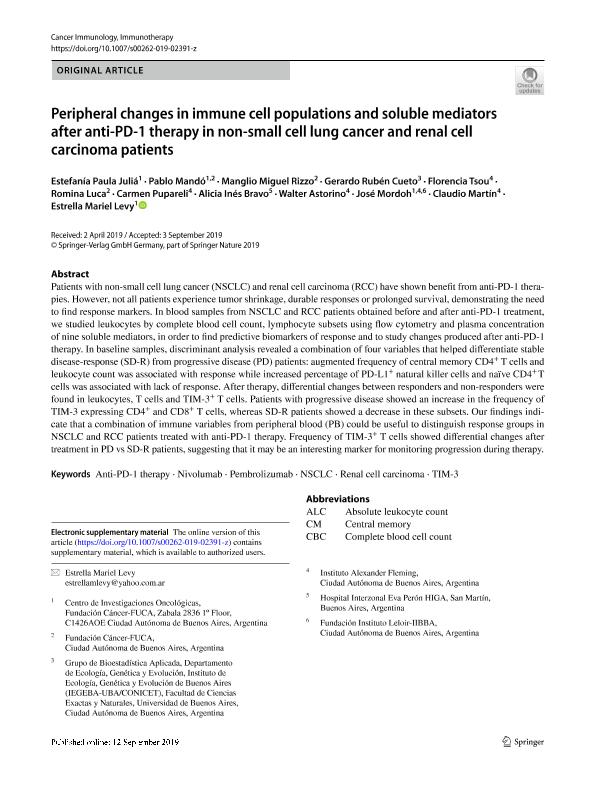Mostrar el registro sencillo del ítem
dc.contributor.author
Juliá, Estefanía Paula

dc.contributor.author
Mandó, Pablo

dc.contributor.author
Rizzo, Manglio Miguel

dc.contributor.author
Cueto, Gerardo Ruben

dc.contributor.author
Tsou, Florencia
dc.contributor.author
Luca, Romina
dc.contributor.author
Pupareli, Carmen
dc.contributor.author
Bravo, Alicia Inés
dc.contributor.author
Astorino, Walter
dc.contributor.author
Mordoh, José
dc.contributor.author
Martín, Claudio
dc.contributor.author
Levy, Estrella Mariel

dc.date.available
2022-12-14T12:45:19Z
dc.date.issued
2019-10
dc.identifier.citation
Juliá, Estefanía Paula; Mandó, Pablo; Rizzo, Manglio Miguel; Cueto, Gerardo Ruben; Tsou, Florencia; et al.; Peripheral changes in immune cell populations and soluble mediators after anti-PD-1 therapy in non-small cell lung cancer and renal cell carcinoma patients; Springer; Cancer Immunology Immunotherapy; 68; 10; 10-2019; 1585-1596
dc.identifier.issn
0340-7004
dc.identifier.uri
http://hdl.handle.net/11336/181082
dc.description.abstract
Patients with non-small cell lung cancer (NSCLC) and renal cell carcinoma (RCC) have shown benefit from anti-PD-1 therapies. However, not all patients experience tumor shrinkage, durable responses or prolonged survival, demonstrating the need to find response markers. In blood samples from NSCLC and RCC patients obtained before and after anti-PD-1 treatment, we studied leukocytes by complete blood cell count, lymphocyte subsets using flow cytometry and plasma concentration of nine soluble mediators, in order to find predictive biomarkers of response and to study changes produced after anti-PD-1 therapy. In baseline samples, discriminant analysis revealed a combination of four variables that helped differentiate stable disease-response (SD-R) from progressive disease (PD) patients: augmented frequency of central memory CD4+ T cells and leukocyte count was associated with response while increased percentage of PD-L1+ natural killer cells and naïve CD4+ T cells was associated with lack of response. After therapy, differential changes between responders and non-responders were found in leukocytes, T cells and TIM-3+ T cells. Patients with progressive disease showed an increase in the frequency of TIM-3 expressing CD4+ and CD8+ T cells, whereas SD-R patients showed a decrease in these subsets. Our findings indicate that a combination of immune variables from peripheral blood (PB) could be useful to distinguish response groups in NSCLC and RCC patients treated with anti-PD-1 therapy. Frequency of TIM-3+ T cells showed differential changes after treatment in PD vs SD-R patients, suggesting that it may be an interesting marker for monitoring progression during therapy.
dc.format
application/pdf
dc.language.iso
eng
dc.publisher
Springer

dc.rights
info:eu-repo/semantics/openAccess
dc.rights.uri
https://creativecommons.org/licenses/by-nc-sa/2.5/ar/
dc.subject
ANTI-PD-1 THERAPY
dc.subject
NIVOLUMAB
dc.subject
NSCLC
dc.subject
PEMBROLIZUMAB
dc.subject
RENAL CELL CARCINOMA
dc.subject
TIM-3
dc.subject.classification
Bioquímica y Biología Molecular

dc.subject.classification
Medicina Básica

dc.subject.classification
CIENCIAS MÉDICAS Y DE LA SALUD

dc.title
Peripheral changes in immune cell populations and soluble mediators after anti-PD-1 therapy in non-small cell lung cancer and renal cell carcinoma patients
dc.type
info:eu-repo/semantics/article
dc.type
info:ar-repo/semantics/artículo
dc.type
info:eu-repo/semantics/publishedVersion
dc.date.updated
2020-11-20T14:45:50Z
dc.journal.volume
68
dc.journal.number
10
dc.journal.pagination
1585-1596
dc.journal.pais
Alemania

dc.description.fil
Fil: Juliá, Estefanía Paula. Fundación Cáncer. Centro de Investigaciones Oncológicas; Argentina. Consejo Nacional de Investigaciones Científicas y Técnicas; Argentina
dc.description.fil
Fil: Mandó, Pablo. Fundación Cáncer. Centro de Investigaciones Oncológicas; Argentina
dc.description.fil
Fil: Rizzo, Manglio Miguel. Fundación Cáncer. Centro de Investigaciones Oncológicas; Argentina. Consejo Nacional de Investigaciones Científicas y Técnicas; Argentina
dc.description.fil
Fil: Cueto, Gerardo Ruben. Consejo Nacional de Investigaciones Científicas y Técnicas. Oficina de Coordinación Administrativa Ciudad Universitaria. Instituto de Ecología, Genética y Evolución de Buenos Aires. Universidad de Buenos Aires. Facultad de Ciencias Exactas y Naturales. Instituto de Ecología, Genética y Evolución de Buenos Aires; Argentina
dc.description.fil
Fil: Tsou, Florencia. Instituto Alexander Fleming; Argentina
dc.description.fil
Fil: Luca, Romina. Fundación Cáncer. Centro de Investigaciones Oncológicas; Argentina
dc.description.fil
Fil: Pupareli, Carmen. Instituto Alexander Fleming; Argentina
dc.description.fil
Fil: Bravo, Alicia Inés. Gobierno de la Provincia de Buenos Aires. Hospital Interzonal General de Agudos Presidente Peron; Argentina
dc.description.fil
Fil: Astorino, Walter. Instituto Alexander Fleming; Argentina
dc.description.fil
Fil: Mordoh, José. Consejo Nacional de Investigaciones Científicas y Técnicas. Oficina de Coordinación Administrativa Parque Centenario. Instituto de Investigaciones Bioquímicas de Buenos Aires. Fundación Instituto Leloir. Instituto de Investigaciones Bioquímicas de Buenos Aires; Argentina
dc.description.fil
Fil: Martín, Claudio. Instituto Alexander Fleming; Argentina
dc.description.fil
Fil: Levy, Estrella Mariel. Fundación Cáncer. Centro de Investigaciones Oncológicas; Argentina. Consejo Nacional de Investigaciones Científicas y Técnicas; Argentina
dc.journal.title
Cancer Immunology Immunotherapy

dc.relation.alternativeid
info:eu-repo/semantics/altIdentifier/url/https://link.springer.com/article/10.1007%2Fs00262-019-02391-z
dc.relation.alternativeid
info:eu-repo/semantics/altIdentifier/doi/http://dx.doi.org/10.1007/s00262-019-02391-z
Archivos asociados
